Advantages of Backfill Mining Method for Small and Medium-Sized Mines in China: Safe, Eco-Friendly, and Efficient Mining
Abstract
1. Introduction
2. Status Quo of Small- and Medium-Sized Mines in China
2.1. Current Status of Mining Methods and Equipment in SM Mines of China
2.2. Current Status of Mine Tailings Discharge in SM Mines of China
3. Problems in Small and Medium Sized Underground Mines
3.1. Hidden Danger of Goaf Safety
3.2. Hidden Danger of Goaf Safety Tailings Ponds
3.3. Depletion Losses of Ore
4. Suggestions for Small- and Medium-Sized Underground Mines
Prospects for the Application of Backfill Mining Methods
5. Conclusions
- (1)
- The second section of this paper highlights the inefficient mining methods and equipment widely used by SM mines in China. These include the room-and-pillar method, shrinkage stoping mining method, and sublevel caving mining method, which result in a high rate of ore loss depletion. The equipment used, such as pneumatic rock drills, electric rakes, and rock loaders, are also inefficient in transporting ore. Therefore, there is an urgent need for SM mines in China to upgrade their mining equipment with improved methods to increase efficiency. Additionally, the section also sheds light on the inadequate management of mine waste, which is mostly discharged into tailings ponds, causing environmental pollution and posing safety hazards that require improvement.
- (2)
- The third section of this paper provides a review of the current challenges faced by SM mines in China. These challenges include inadequate management and disposal of mining areas, which can lead to accidents such as mining area collapse and pose a safety hazard. Additionally, there is inadequate management of tailings ponds, which can cause potential pollution and safety hazards. Finally, the utilization rate of small- and medium-sized ores in China is too low, mostly due to the loss of ore depletion caused by outdated mining technology.
- (3)
- In the fourth section of this paper, we provided recommendations for the development direction of other SM mines in China based on the successful example of the Shishudi Gold Mine. These recommendations include introducing backfill mining methods, actively building backfill systems, promoting the reuse of mine solid waste such as tailings, and introducing advanced extraction equipment. These initiatives are well-suited to the development of small- and medium-sized mines in China, as they can improve mining productivity and economic efficiency while ensuring mining safety and environmental management.
Author Contributions
Funding
Institutional Review Board Statement
Informed Consent Statement
Data Availability Statement
Acknowledgments
Conflicts of Interest
References
- Yu, H.; Li, S.; Wang, X. The Recent Progress China Has Made in the Backfill Mining Method, Part I: The Theory and Equipment of Backfill Pipeline Transportation. Minerals 2021, 11, 1274. [Google Scholar] [CrossRef]
- Wang, J.; Huang, X.; Hu, K.; Li, X. Evaluation on community development programs in mining industry: A case study of small and medium enterprise in China. Resour. Policy 2018, 59, 516–524. [Google Scholar] [CrossRef]
- Li, S.; Zhao, Z.; Yu, H.; Wang, X. The Recent Progress China Has Made in the Backfill Mining Method, Part II: The Composition and Typical Examples of Backfill Systems. Minerals 2021, 11, 1362. [Google Scholar] [CrossRef]
- Song, X.; Mu, X. The safety regulation of small-scale coal mines in China: Analysing the interests and influences of stakeholders. Energy Policy 2013, 52, 472–481. [Google Scholar] [CrossRef]
- Li, Z.Y.; Ma, Z.W.; van der Kuijp, T.J.; Yuan, Z.W.; Huang, L. A review of soil heavy metal pollution from mines in China: Pollution and health risk assessment. Sci. Total Environ. 2014, 468, 843–853. [Google Scholar] [CrossRef]
- Wang, G.; Xu, Y.; Ren, H. Intelligent and ecological coal mining as well as clean utilization technology in China: Review and prospects. Int. J. Min. Sci. Technol. 2019, 29, 161–169. [Google Scholar] [CrossRef]
- Yu, H.; Li, S.; Wang, X. The Recent Progress China Has Made in the Backfill Mining Method, Part III: Practical Engineering Problems in Stope and Goaf Backfill. Minerals 2022, 12, 88. [Google Scholar] [CrossRef]
- Shen, L.; Cheng, S.; Gunson, A.J.; Wan, H. Urbanization, sustainability and the utilization of energy and mineral resources in China. Cities 2005, 22, 287–302. [Google Scholar] [CrossRef]
- Zhai, M.; Hu, R.; Wang, Y.; Jiang, S.; Wang, R.; Li, J.; Chen, H.; Yang, Z.; Lü, Q.; Qi, T.; et al. Mineral Resource Science in China: Review and perspective. Geogr. Sustain. 2021, 2, 107–114. [Google Scholar] [CrossRef]
- Li, C.; Wang, A.; Chen, X.; Chen, Q.; Zhang, Y.; Li, Y. Regional distribution and sustainable development strategy of mineral resources in China. Chin. Geogr. Sci. 2013, 23, 470–481. [Google Scholar] [CrossRef]
- Yu, H.; Zahidi, I. Environmental hazards posed by mine dust, and monitoring method of mine dust pollution using remote sensing technologies: An overview. Sci. Total Environ. 2022, 864, 161135. [Google Scholar] [CrossRef] [PubMed]
- Li, X.B.; Qiu, J.D.; Zhao, Y.Z.; Chen, Z.H.; Li, D.Y. Instantaneous and long-term deformation characteristics of deep room-pillar system induced by pillar recovery. Trans. Nonferrous Met. Soc. China 2020, 30, 2775–2791. [Google Scholar] [CrossRef]
- Skrzypkowski, K. Case studies of rock bolt support loads and rock mass monitoring for the room and pillar method in the legnica-głogów copper district in Poland. Energies 2020, 13, 2998. [Google Scholar] [CrossRef]
- Ataei, M.; Sereshki, F.; Jamshidi, M.; Jalali, S.M.E. Suitable mining method for Golbini No. 8 deposit in Jajarm (Iran) using TOPSIS method. Min. Technol. 2008, 117, 1–5. [Google Scholar] [CrossRef]
- Yu, S.-F.; Wu, A.-X.; Wang, Y.-M.; Li, T. Pre-reinforcement grout in fractured rock masses and numerical simulation for optimizing shrinkage stoping configuration. J. Cent. South Univ. 2017, 24, 2924–2931. [Google Scholar] [CrossRef]
- Kim, H.H.; Swanson, N.R. Mining big data using parsimonious factor, machine learning, variable selection and shrinkage methods. Int. J. Forecast. 2018, 34, 339–354. [Google Scholar] [CrossRef]
- Balusa, B.C. Analysing the Role of Safety Level and Capital Investment in Selection of Underground Metal Mining Method. Int. J. Min. Geo-Eng. 2021, 55, 125–131. [Google Scholar]
- Lin, Y. Research on Mining Technology of Steeply Inclined Thin Ore Body in High-grade Content Mine. IOP Conf. Ser. Earth Environ. Sci. 2021, 632, 022038. [Google Scholar]
- Brunton, I.; Fraser, S.; Hodgkinson, J.; Stewart, P. Parameters influencing full scale sublevel caving material recovery at the Ridgeway gold mine. Int. J. Rock Mech. Min. Sci. 2010, 47, 647–656. [Google Scholar] [CrossRef]
- Rempel, D.; Antonucci, A.; Barr, A.; Cooper, M.R.; Martin, B.; Neitzel, R. Pneumatic rock drill vs. electric rotary hammer drill: Productivity, vibration, dust, and noise when drilling into concrete. Appl. Ergon. 2019, 74, 31–36. [Google Scholar] [CrossRef] [PubMed]
- Yu, H.; Zhao, C.; Li, S.; Wang, Z.; Zhang, Y. Pre-Work for the Birth of Driver-Less Scraper (LHD) in the Underground Mine: The Path Tracking Control Based on an LQR Controller and Algorithms Comparison. Sensors 2021, 21, 7839. [Google Scholar] [CrossRef]
- Wang, J.; Yang, S.; Li, Y.; Wei, L.; Liu, H. Caving mechanisms of loose top-coal in longwall top-coal caving mining method. Int. J. Rock Mech. Min. Sci. 2014, 71, 160–170. [Google Scholar] [CrossRef]
- Li, S.; Zhang, Y.; Feng, R.; Yu, H.; Pan, J.; Bian, J. Environmental Safety Analysis of Red Mud-Based Cemented Backfill on Groundwater. Int. J. Environ. Res. Public Health 2021, 18, 8094. [Google Scholar] [CrossRef] [PubMed]
- Li, S.; Zhang, R.; Feng, R.; Hu, B.; Wang, G.; Yu, H. Feasibility of Recycling Bayer Process Red Mud for the Safety Backfill Mining of Layered Soft Bauxite under Coal Seams. Minerals 2021, 11, 722. [Google Scholar] [CrossRef]
- Jia, H.; Yan, B.; Yilmaz, E. A large goaf group treatment by means of mine backfill technology. Adv. Civ. Eng. 2021, 2021, 3737145. [Google Scholar] [CrossRef]
- Zhou, J.; Li, X.; Mitri, H.S.; Wang, S.; Wei, W. Identification of large-scale goaf instability in underground mine using particle swarm optimization and support vector machine. Int. J. Min. Sci. Technol. 2013, 23, 701–707. [Google Scholar] [CrossRef]
- Li, S.; Yu, Z.; Yu, H.; Wang, X. The Recent Progress China Has Made in High-Concentration Backfill. Sustainability 2022, 14, 2758. [Google Scholar] [CrossRef]
- Li, S.; Yu, L.; Jiang, W.; Yu, H.; Wang, X. The Recent Progress China Has Made in Green Mine Construction, Part I: Mining Groundwater Pollution and Sustainable Mining. Int. J. Environ. Res. Public Health 2022, 19, 5673. [Google Scholar] [CrossRef]
- Koppe, J.C. Lessons Learned from the Two Major Tailings Dam Accidents in Brazil. Mine Water Environ. 2021, 40, 166–173. [Google Scholar] [CrossRef]
- Porsani, J.L.; Jesus, F.A.N.D.; Stangari, M.C. GPR survey on an iron mining area after the collapse of the tailings dam I at the Córrego do Feijão mine in Brumadinho-MG, Brazil. Remote Sens. 2019, 11, 860. [Google Scholar] [CrossRef]
- Wang, Y.; Zheng, G.; Wang, X. Development and application of a goaf-safety monitoring system using multi-sensor information fusion. Tunn. Undergr. Space Technol. 2019, 94, 103112. [Google Scholar] [CrossRef]
- Wang, F.; Zhang, C.; Zhang, X.; Song, Q. Overlying strata movement rules and safety mining technology for the shallow depth seam proximity beneath a room mining goaf. Int. J. Min. Sci. Technol. 2015, 25, 139–143. [Google Scholar] [CrossRef]
- Hu, B.; Zhang, Q.; Li, S.; Yu, H.; Wang, X.; Wang, H. Application of Numerical Simulation Methods in Solving Complex Mining Engineering Problems in Dingxi Mine, China. Minerals 2022, 12, 123. [Google Scholar] [CrossRef]
- Li, X.; Liu, Z.; Yang, S. Similar physical modeling of roof stress and subsidence in room and pillar mining of a gently inclined medium-thick phosphate rock. Adv. Civ. Eng. 2021, 2021, 6686981. [Google Scholar] [CrossRef]
- Chin, W.Q.; Lee, Y.H.; Amran, M.; Fediuk, R.; Vatin, N.; Kueh, A.B.H.; Lee, Y.Y. A Sustainable Reuse of Agro-Industrial Wastes into Green Cement Bricks. Materials 2022, 15, 1713. [Google Scholar] [CrossRef]
- Imbabi, M.S.; Carrigan, C.; McKenna, S. Trends and developments in green cement and concrete technology. Int. J. Sustain. Built Environ. 2012, 1, 194–216. [Google Scholar] [CrossRef]
- Wu, M.; Zhang, Y.; Ji, Y.; Liu, G.; Liu, C.; She, W.; Sun, W. Reducing Environmental Impacts and Carbon Emissions: Study of Effects of Superfine Cement Particles on Blended Cement Containing High Volume Mineral Admixtures. J. Clean. Prod. 2018, 196, 358–369. [Google Scholar] [CrossRef]
- Ye, Z.H.; Chen, L.; Yan, Q.; Wang, A.J. A review of exploitation, utilization and strategic research of nonmetallic minerals in china. Appl. Mech. Mater. 2014, 666, 359–362. [Google Scholar] [CrossRef]
- Feng, X.; Zhang, Q. The effect of backfilling materials on the deformation of coal and rock strata containing multiple goaf: A numerical study. Minerals 2018, 8, 224. [Google Scholar] [CrossRef]
- Yu, H.; Zahidi, I. Spatial and temporal variation of vegetation cover in the main mining area of Qibaoshan Town, China: Potential impacts from mining damage, solid waste discharge and land reclamation. Sci. Total Environ. 2023, 859, 160392. [Google Scholar] [CrossRef]
- Yu, H.; Li, S.; Yu, L.; Wang, X. The Recent Progress China Has Made in Green Mine Construction, Part II: Typical Examples of Green Mines. Int. J. Environ. Res. Public Health 2022, 19, 8166. [Google Scholar] [CrossRef]
- Guo, Q.; Yu, H.; Dan, Z.; Li, S. Mining Method Optimization of Gently Inclined and Soft Broken Complex Ore Body Based on AHP and TOPSIS: Taking Miao-Ling Gold Mine of China as an Example. Sustainability 2021, 13, 12503. [Google Scholar] [CrossRef]
- Martins, N.P.; Srivastava, S.; Simão, F.V.; Niu, H.; Perumal, P.; Snellings, R.; Illikainen, M.; Chambart, H.; Habert, G. Exploring the potential for utilization of medium and highly sulfidic mine tailings in construction materials: A review. Sustainability 2021, 13, 12150. [Google Scholar] [CrossRef]
- Li, B.; Guo, Y.; Fang, J. Effect of crystallization temperature on glass-ceramics derived from tailings waste. J. Alloys Compd. 2020, 838, 155503. [Google Scholar] [CrossRef]
- Xu, W.; Shen, K.; Cao, Z.; Liu, F.; Zhang, Y.; Zhang, T.; Ouyang, S. Crystallization and thermal stability effects on tailings glass-ceramics by various heat treating processes. Mater. Chem. Phys. 2021, 263, 124334. [Google Scholar] [CrossRef]
- Huang, L.; Li, X.; Nguyen, T.A. Extremely high phosphate sorption capacity in Cu-Pb-Zn mine tailings. PLoS ONE 2015, 10, e0135364. [Google Scholar] [CrossRef]
- Yu, H. Mining waste: Curb risks to people and the environment. Nature 2023, 615, 586. [Google Scholar] [CrossRef]
- Bicket, M.; Guilcher, S.; Hestin, M.; Hudson, C.; Razzini, P.; Tan, A.; ten Brink, P.; van Dijl, E.; Vanner, R.; Watkins, E. Scoping Study to Identify Potential Circular Economy Actions, Priority Sectors, Material Flows and Value Chains; Publications Office of the European Union: Luxembourg, 2014. [Google Scholar]
- Asr, E.T.; Kakaie, R.; Ataei, M.; Mohammadi, M.R.T. A review of studies on sustainable development in mining life cycle. J. Clean. Prod. 2019, 229, 213–231. [Google Scholar] [CrossRef]
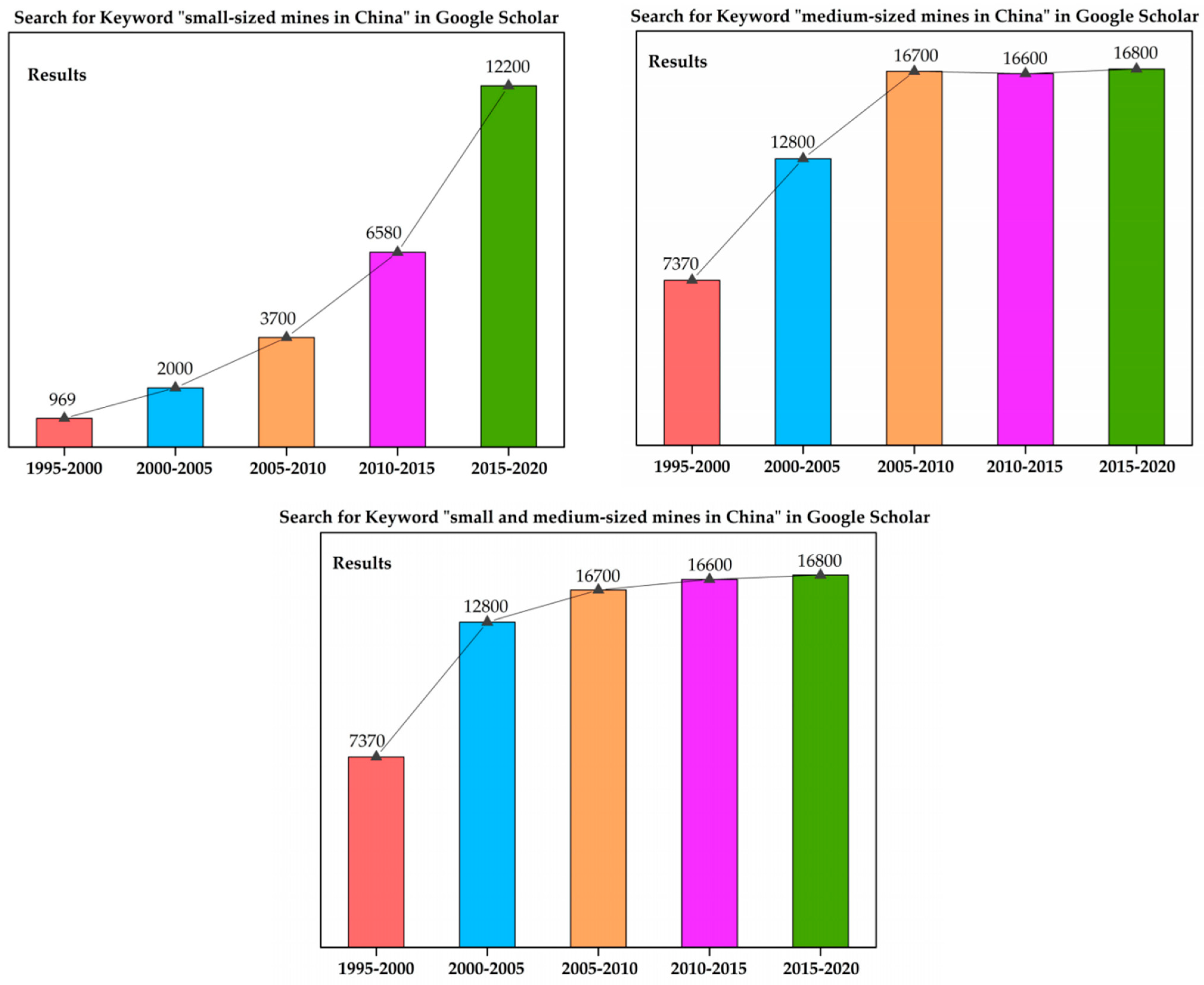

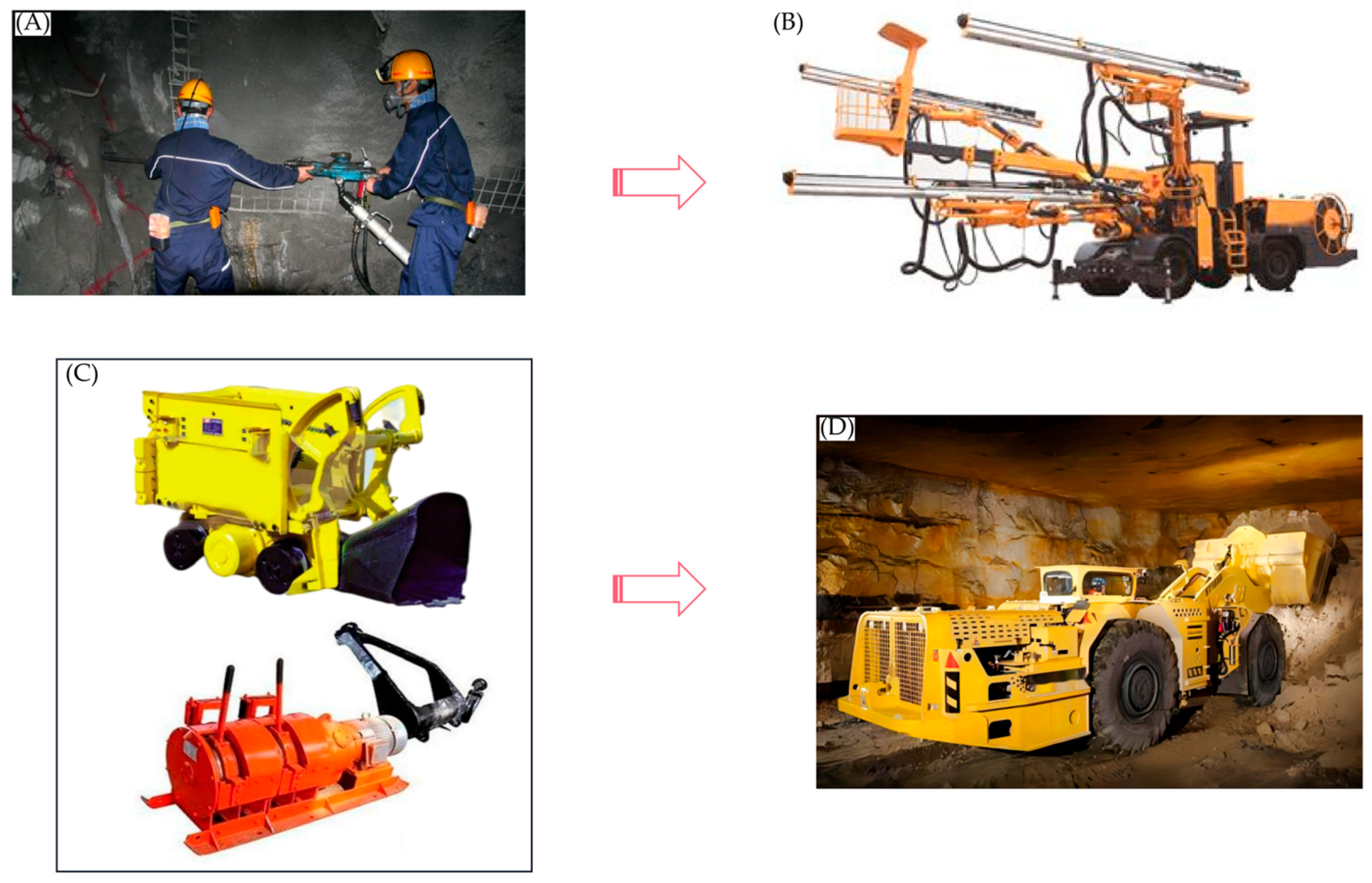
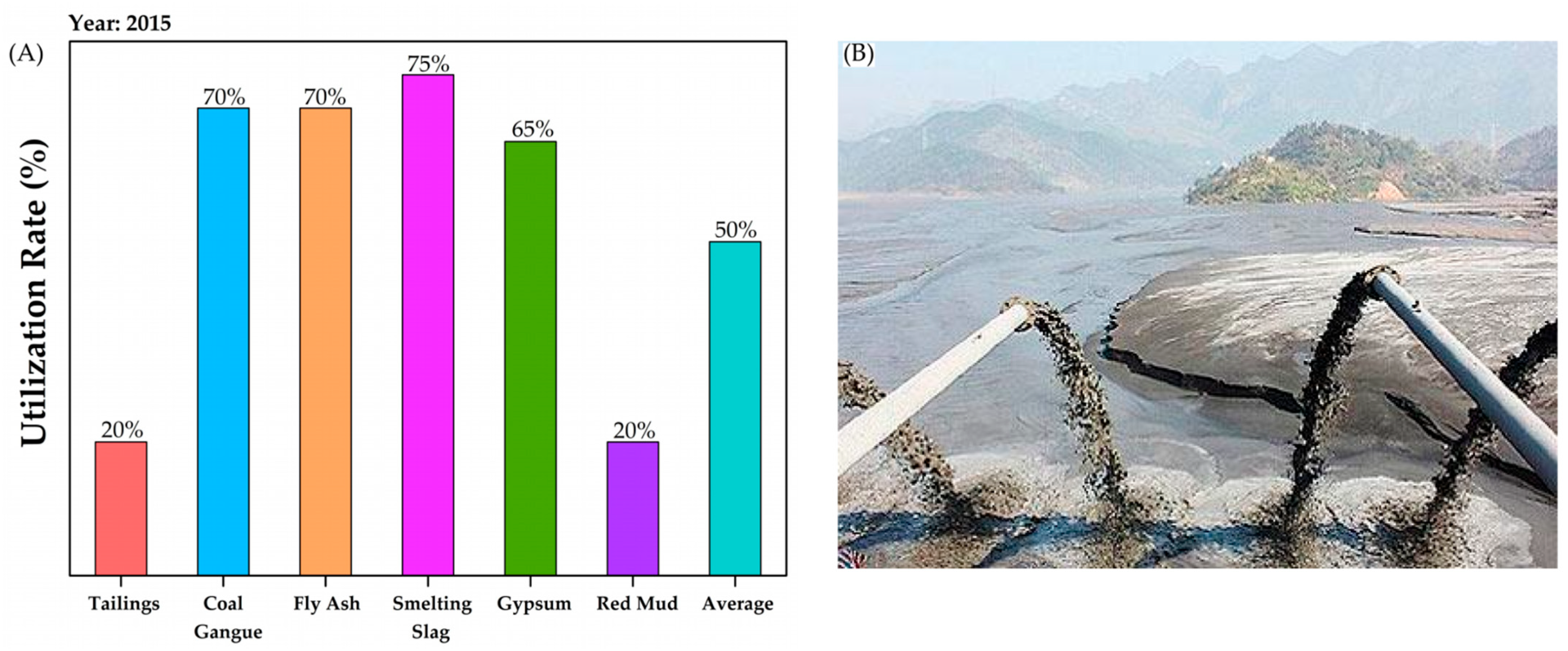

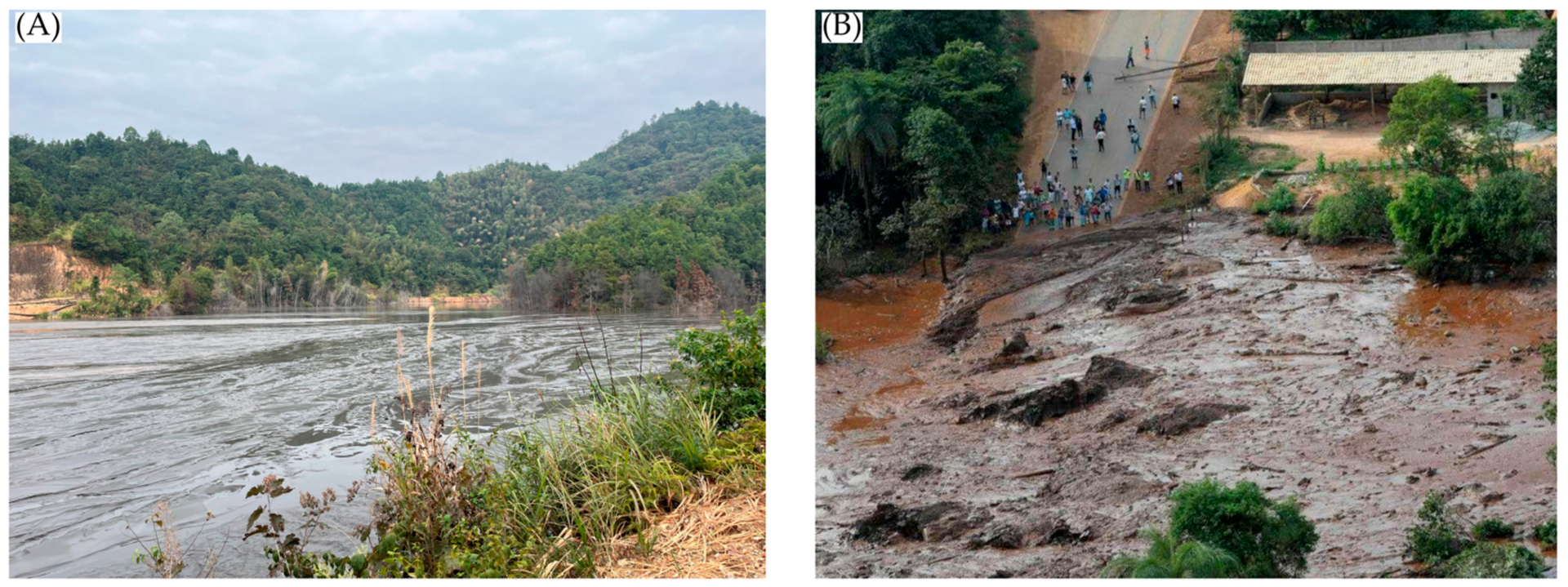
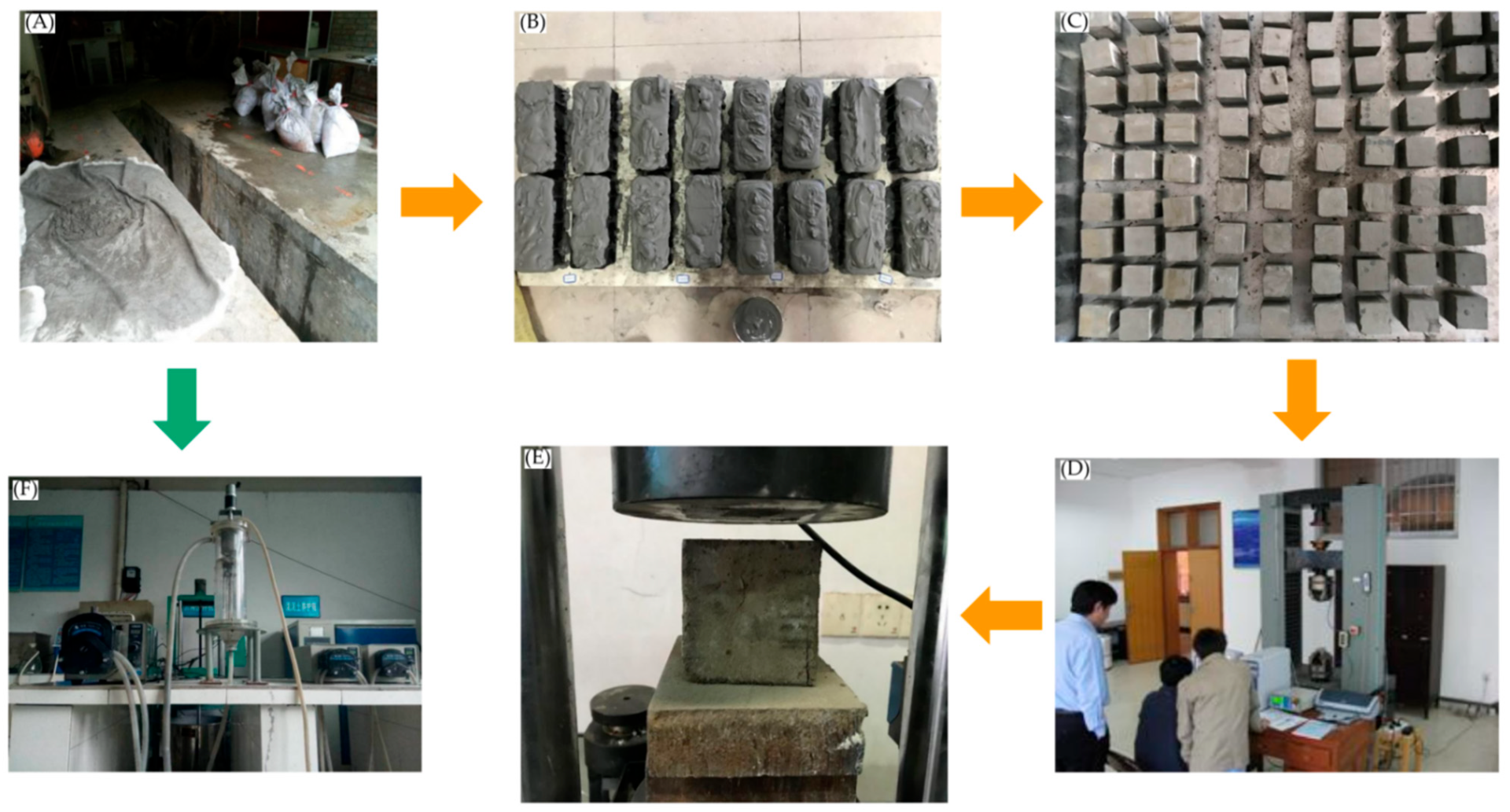
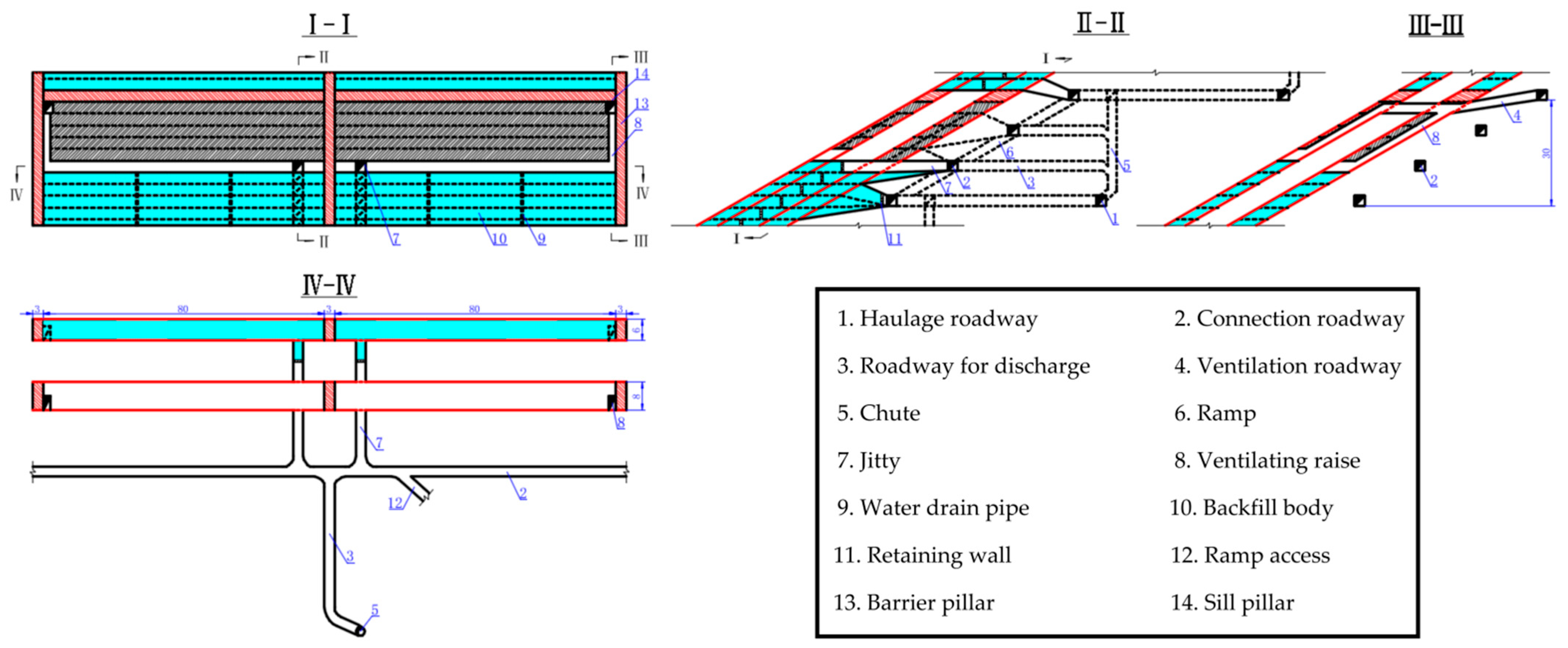
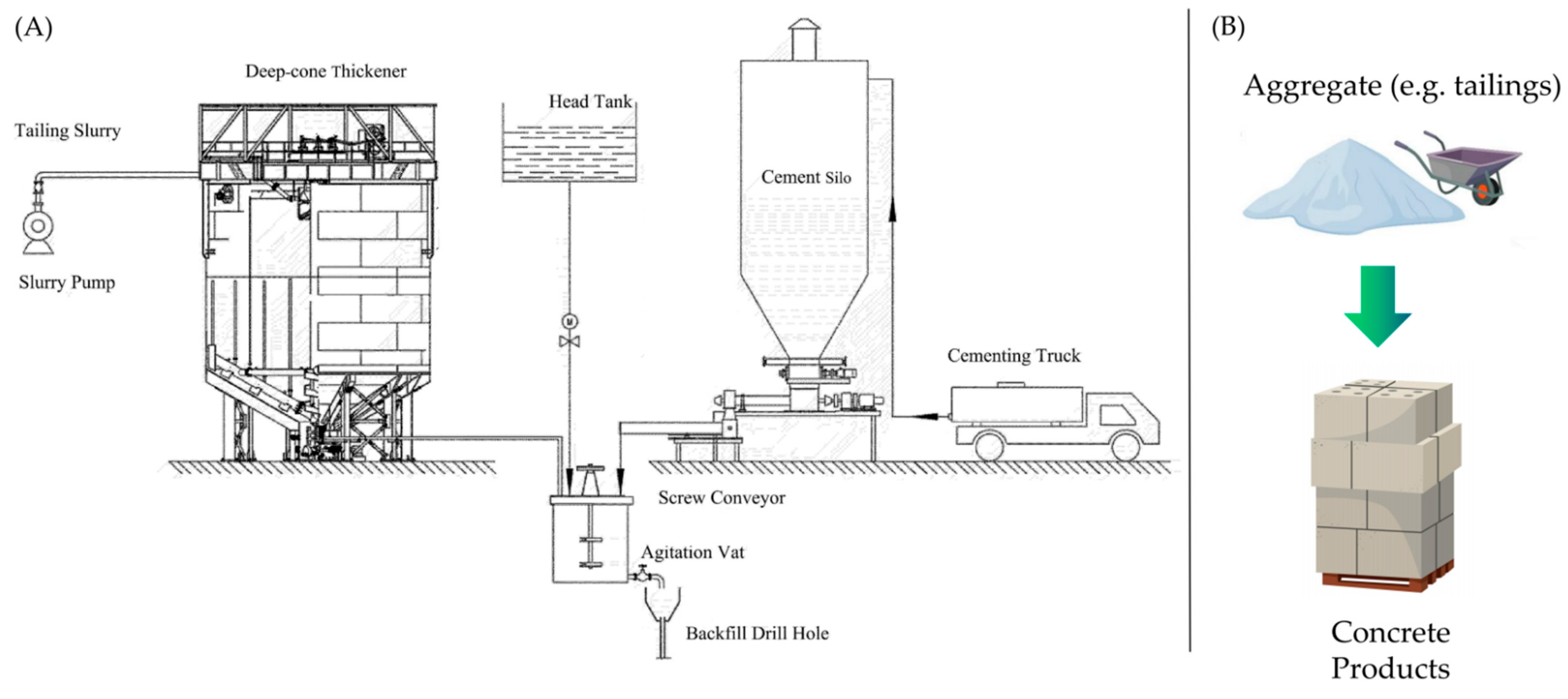

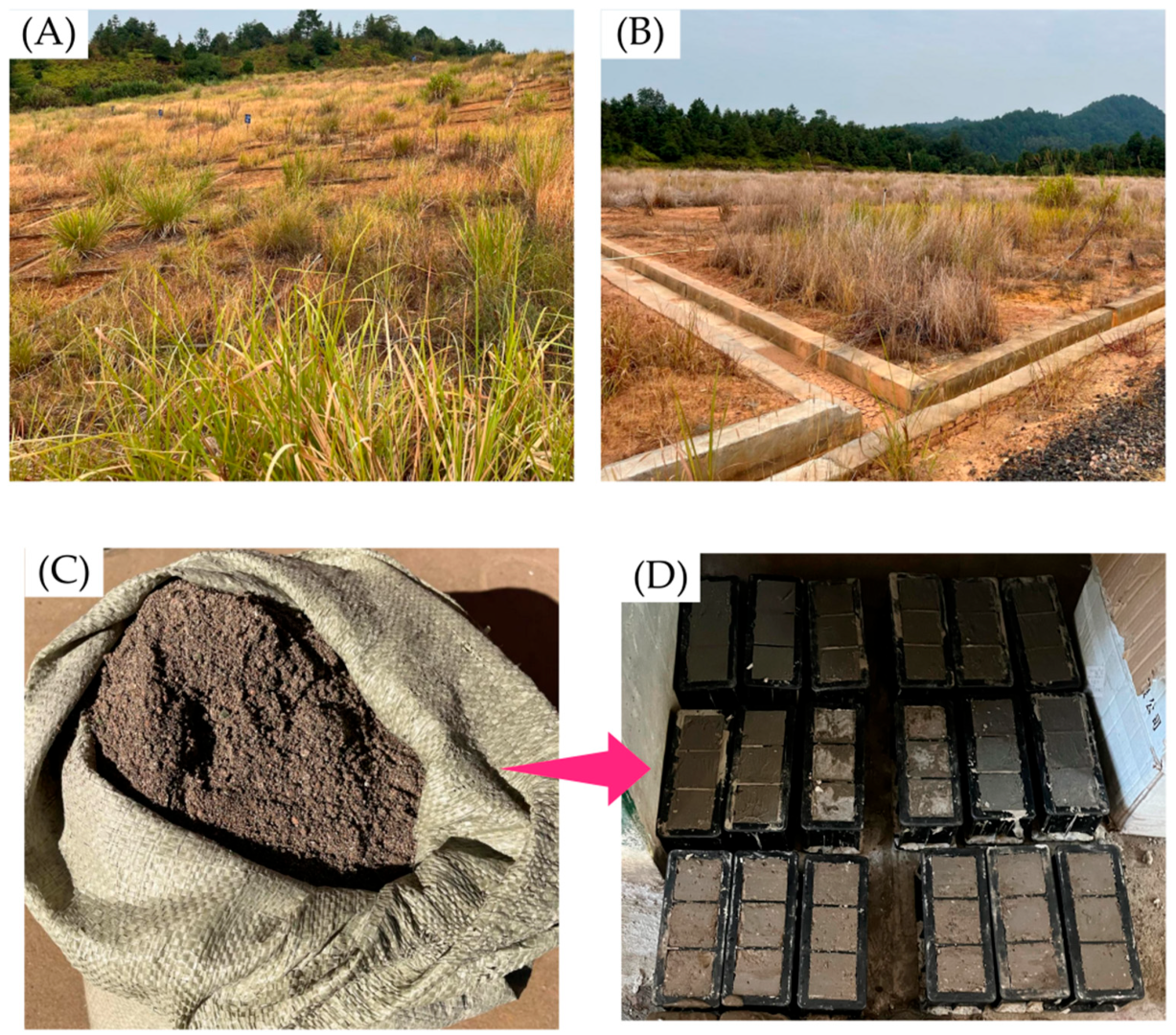
| Scheme | 1 | 2 | 3 | 4 |
|---|---|---|---|---|
| Loading machinery | Four 6.1 cubic yard scrapers | Two front-end loaders and two 26-ton low-profile dump trucks | One AL-60 continuous loader and two 26-ton low-profile dump trucks | One AL-60 continuous loader and two 50-ton low-profile dump trucks |
| Average transportation distance (m) | 150 | 250 | 250 | 400 |
| Number of ore pits required | 3 | 2 | 2 | 1 |
| Annual ore production (*10,000 tons) | 115.2 | 124.8 | 110.4 | 131.0 |
| Shipping fee per ton of ore (Yuan) | 5.6 | 4.3 | 3.5 | 3.8 |
| Species | Production per 10 Thousand Tons (t) | Utilization per 10 Thousand Tons (t) | Utilization Rate (%) | |||||||
|---|---|---|---|---|---|---|---|---|---|---|
| 2005 | 2010 | 2015 | 2005 | 2010 | 2015 | 2005 | 2010 | 2015 | ||
| Tailings | 71,400 | 121,400 | 130,000 | 5000 | 17,000 | 26,000 | 7% | 14% | 20% | |
| Coal Gangue | 37,000 | 59,800 | 73,000 | 19,600 | 36,500 | 51,100 | 53% | 61% | 70% | |
| Fly ash | 30,100 | 48,000 | 56,600 | 19,900 | 32,600 | 39,600 | 66% | 68% | 70% | |
| Smelting slag | 18,000 | 31,700 | 44,000 | 9000 | 19,000 | 33,000 | 50% | 60% | 75% | |
| Gypsum | 5000 | 12,500 | 15,000 | 500 | 5000 | 9750 | 10% | 40% | 65% | |
| Red mud | 1000 | 3000 | 3500 | 20 | 120 | 700 | 2% | 4% | 20% | |
| Total | 162,500 | 276,400 | 322,100 | 54,020 | 110,220 | 160,150 | Average | 33% | 40% | 50% |
| Size Range of Goaf (*10,000 m3) | Mine Quantity Distribution | Volume Distribution of Goaf (Goafs) | ||
|---|---|---|---|---|
| Number | Percentage | Goaf Volume (*10,000 m3) | Percentage | |
| <50 | 303 | 66.3% | 3710.72 | 8.59% |
| 50~100 | 54 | 11.82% | 3866.72 | 8.95% |
| 100~500 | 79 | 17.29% | 17,957.98 | 41.55% |
| 500~1000 | 14 | 3.06% | 8871.04 | 20.53% |
| >1000 | 7 | 1.53% | 8810.8 | 20.38% |
| Total | 457 | 100% | 43,217.26 | 100% |
Disclaimer/Publisher’s Note: The statements, opinions and data contained in all publications are solely those of the individual author(s) and contributor(s) and not of MDPI and/or the editor(s). MDPI and/or the editor(s) disclaim responsibility for any injury to people or property resulting from any ideas, methods, instructions or products referred to in the content. |
© 2023 by the authors. Licensee MDPI, Basel, Switzerland. This article is an open access article distributed under the terms and conditions of the Creative Commons Attribution (CC BY) license (https://creativecommons.org/licenses/by/4.0/).
Share and Cite
Li, S.; Zou, P.; Yu, H.; Hu, B.; Wang, X. Advantages of Backfill Mining Method for Small and Medium-Sized Mines in China: Safe, Eco-Friendly, and Efficient Mining. Appl. Sci. 2023, 13, 7280. https://doi.org/10.3390/app13127280
Li S, Zou P, Yu H, Hu B, Wang X. Advantages of Backfill Mining Method for Small and Medium-Sized Mines in China: Safe, Eco-Friendly, and Efficient Mining. Applied Sciences. 2023; 13(12):7280. https://doi.org/10.3390/app13127280
Chicago/Turabian StyleLi, Shuai, Peiyuan Zou, Haoxuan Yu, Boyi Hu, and Xinmin Wang. 2023. "Advantages of Backfill Mining Method for Small and Medium-Sized Mines in China: Safe, Eco-Friendly, and Efficient Mining" Applied Sciences 13, no. 12: 7280. https://doi.org/10.3390/app13127280
APA StyleLi, S., Zou, P., Yu, H., Hu, B., & Wang, X. (2023). Advantages of Backfill Mining Method for Small and Medium-Sized Mines in China: Safe, Eco-Friendly, and Efficient Mining. Applied Sciences, 13(12), 7280. https://doi.org/10.3390/app13127280







